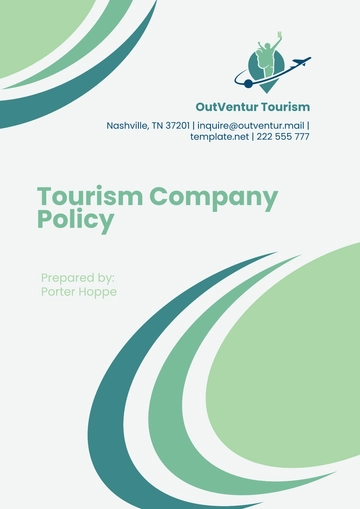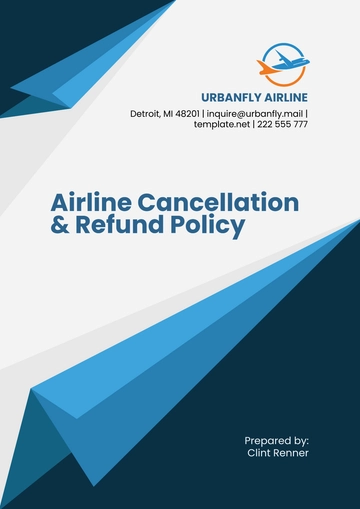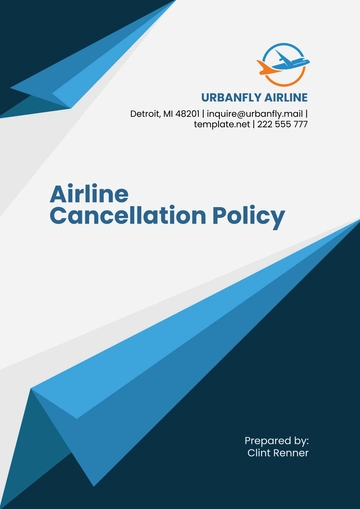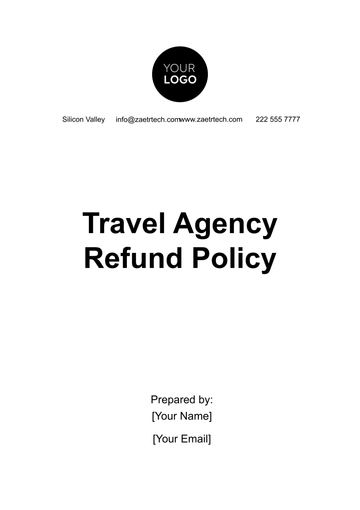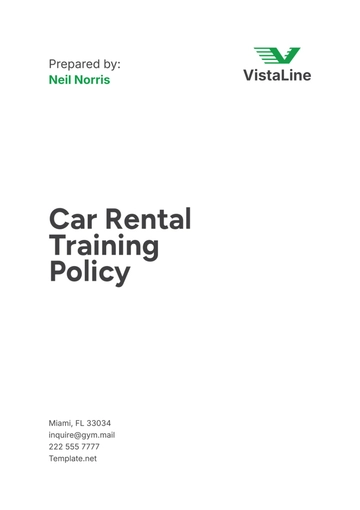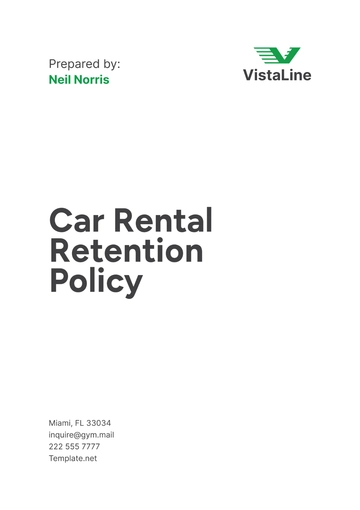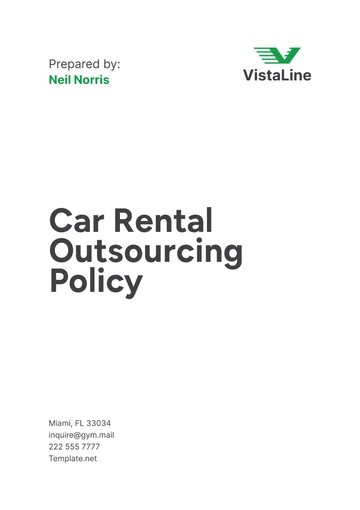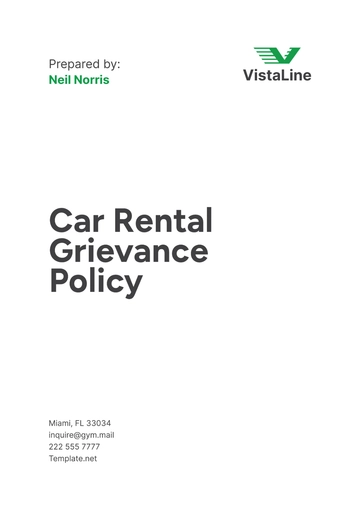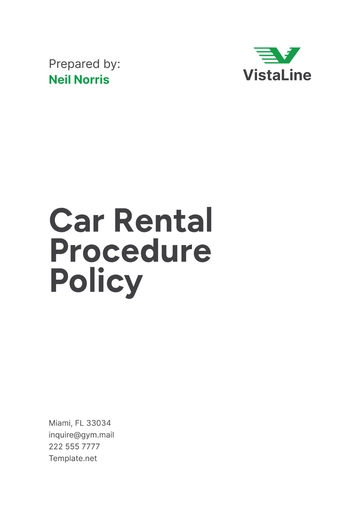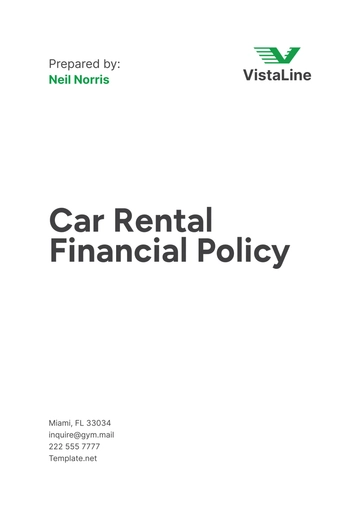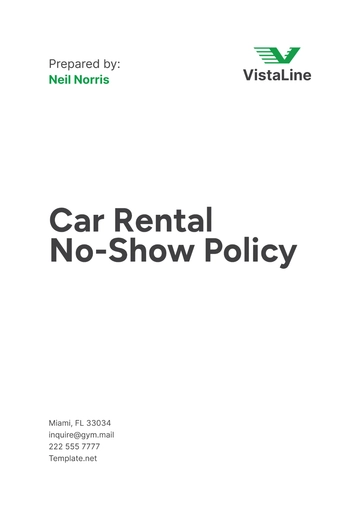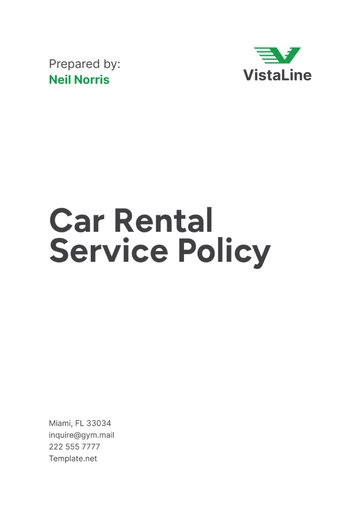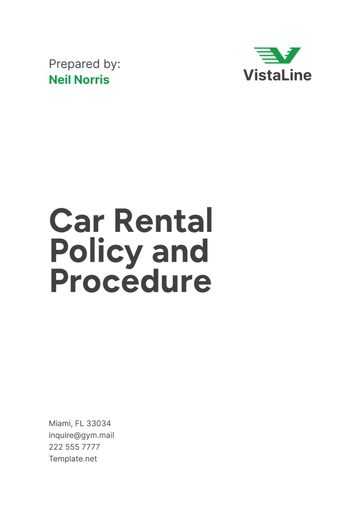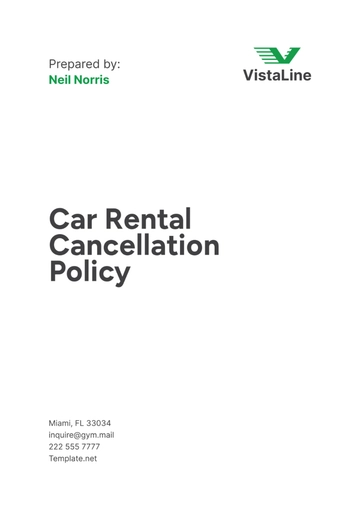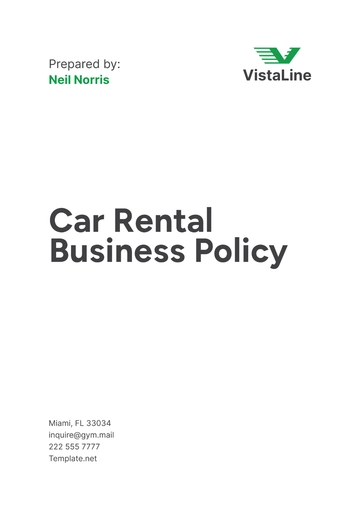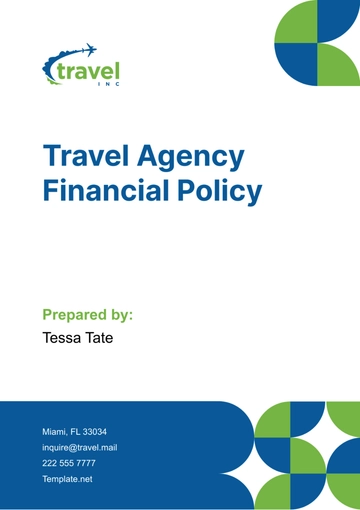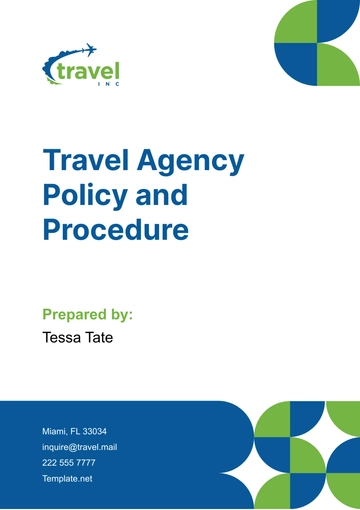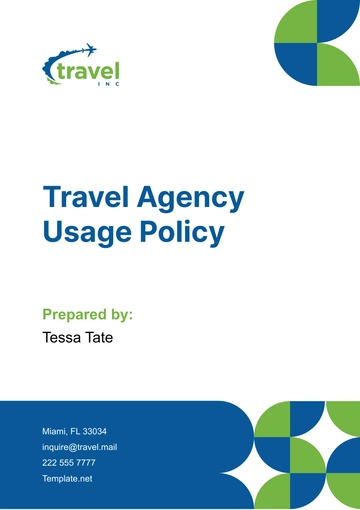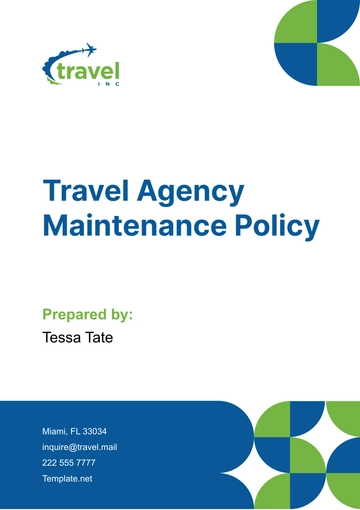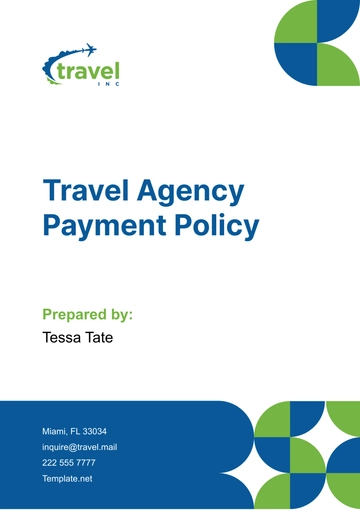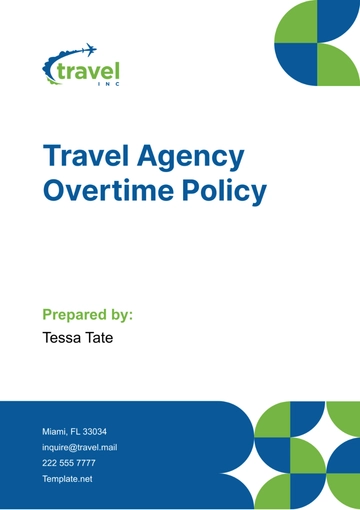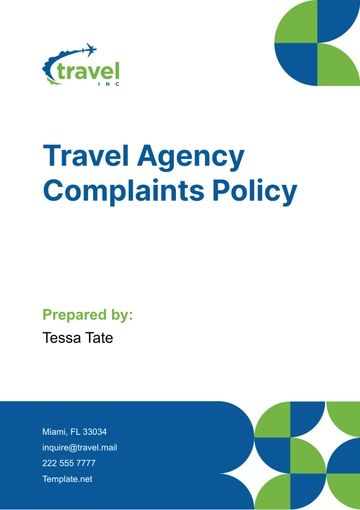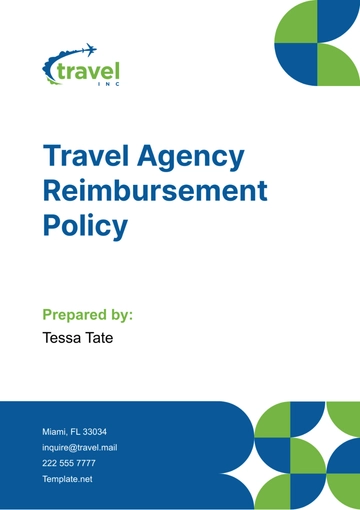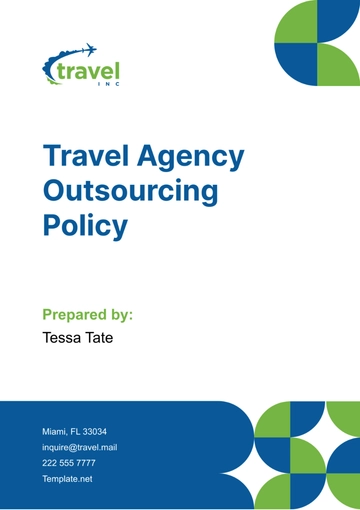Free Car Rental Policy and Procedure

1. Introduction
Welcome to [Your Company Name]'s Car Rental Policy and Procedure document. This comprehensive guide outlines the policies and procedures governing our car rental operations, ensuring consistency, reliability, and high standards of customer service. Adhering to these guidelines helps maintain operational excellence and enhances customer satisfaction.
2. Reservation Policies
Effective reservation policies are crucial for managing customer expectations and ensuring vehicle availability.
2.1 Reservation Process
Customer Inquiry: Customers can inquire about vehicle availability via our website, phone, or email. All inquiries must be responded to promptly and courteously.
Reservation Entry: Once the customer’s rental details are confirmed, the reservation must be entered into our system accurately, including customer contact details, rental dates, vehicle type, and any special requirements.
Confirmation: A confirmation email is sent to the customer, detailing the reservation number, vehicle information, pickup location, and rental terms and conditions.
2.2 Cancellation Policy
Cancellation Window: Customers can cancel their reservation without penalty up to 24 hours before the scheduled pickup time.
Late Cancellations: Cancellations made within 24 hours of the pickup time may incur a fee equivalent to one day's rental charge.
No-Shows: Customers who do not show up for their reservation and do not cancel will be charged a no-show fee equivalent to one day's rental charge.
2.3 Modifications to Reservations
Changes in Rental Dates: Customers can modify their rental dates subject to vehicle availability. Any changes should be updated in the reservation system, and a confirmation email should be sent to the customer.
Vehicle Upgrades/Downgrades: Customers requesting a different vehicle type will be accommodated based on availability. Any changes in rental rates should be communicated and confirmed with the customer.
3. Vehicle Pickup and Return Procedures
Proper vehicle pickup and return procedures are essential for maintaining operational efficiency and customer satisfaction.
3.1 Vehicle Pickup
Verification: Customers must present a valid driver’s license, credit card, and reservation confirmation at the time of pickup.
Vehicle Inspection: Conduct a thorough inspection of the vehicle in the presence of the customer. Document any pre-existing damage and have the customer acknowledge the vehicle condition report.
Rental Agreement: Review the rental agreement with the customer, ensuring they understand all terms and conditions, including mileage limits, fuel policy, and return procedures.
Vehicle Features: Provide a brief overview of the vehicle’s features and controls. Ensure the customer is comfortable with the vehicle’s operation.
Signatures: Obtain the customer’s signature on the rental agreement and vehicle condition report.
3.2 Vehicle Return
Return Inspection: Upon return, inspect the vehicle for new damage or excessive wear and tear. Compare the current condition with the initial vehicle condition report.
Mileage and Fuel Check: Record the vehicle’s mileage and fuel level. Ensure they align with the rental agreement terms.
Finalizing the Rental: Calculate the final rental charges, including any additional fees for fuel, mileage, or damages. Provide the customer with a final invoice and receipt.
Customer Feedback: Encourage the customer to provide feedback on their rental experience. This information is valuable for improving our services.
3.3 Post-Return Inspection
Detailed Inspection: After the customer has left, perform a detailed inspection of the vehicle. Document any damages or issues that were not identified during the initial return inspection.
Maintenance Scheduling: Schedule any necessary repairs or maintenance. Update the vehicle’s status in the reservation system to reflect its availability.
4. Payment and Billing Procedures
Accurate and transparent payment and billing procedures are vital for financial management and customer trust.
4.1 Payment Methods
Accepted Payment Methods: We accept credit cards, debit cards, and online payments. Cash payments are not accepted for security reasons.
Pre-Authorization: A pre-authorization hold will be placed on the customer’s credit card at the time of reservation to ensure funds are available. This hold will be released upon return of the vehicle, minus any applicable charges.
4.2 Billing Procedures
Initial Charges: At the time of vehicle pickup, the initial rental charges, including any optional services or insurance, will be billed to the customer’s credit card.
Final Charges: Upon vehicle return, final charges will be calculated, including any additional fees for extra mileage, fuel, or damages. A detailed invoice will be provided to the customer.
Dispute Resolution: Any billing disputes should be addressed promptly and professionally. Customers can contact our billing department for assistance, and disputes should be resolved within five business days.
4.3 Refunds and Adjustments
Refund Eligibility: Refunds are available for cancellations made within the specified window or if the customer experiences a verifiable issue with the vehicle.
Processing Refunds: Approved refunds will be processed within 7-10 business days. Customers will be notified of the refund status via email.
Adjustments: Any adjustments to the final bill, such as discounts or compensations for inconveniences, must be approved by a manager and documented in the reservation system.
5. Maintenance and Cleaning Procedures
Regular maintenance and cleaning of our vehicles are essential to ensure safety, reliability, and customer satisfaction.
5.1 Routine Maintenance
Maintenance Schedule: Each vehicle in our fleet follows a strict maintenance schedule, including oil changes, tire rotations, brake inspections, and fluid checks.
Maintenance Records: Detailed records of all maintenance activities must be kept for each vehicle. These records are essential for tracking the vehicle’s condition and history.
Inspection Protocols: Vehicles should be inspected after every rental to identify any maintenance needs. Preventive maintenance should be scheduled based on mileage and time intervals.
5.2 Cleaning Procedures
Interior Cleaning: After each rental, the interior of the vehicle must be thoroughly cleaned and sanitized. This includes vacuuming, wiping down surfaces, and disinfecting high-touch areas.
Exterior Cleaning: The exterior of the vehicle should be washed and checked for any damages. Regular washing helps maintain the vehicle’s appearance and prevents long-term damage from dirt and grime.
Quality Check: A final quality check should be conducted to ensure the vehicle meets our cleanliness standards before being made available for the next rental.
5.3 Damage Repairs
Damage Assessment: Any damage identified during vehicle inspections must be documented and assessed. Minor damages should be repaired immediately, while significant damages may require the vehicle to be temporarily removed from the fleet.
Approved Repair Vendors: Repairs should be conducted by approved vendors who meet our quality and cost standards. All repairs must be documented in the vehicle’s maintenance records.
Customer Notification: If damages are identified during the return inspection, the customer should be notified of any potential charges promptly. Provide a detailed explanation and a revised invoice if applicable.
6. Customer Service Protocols
Exceptional customer service is a cornerstone of our business. Our protocols ensure that every customer interaction is positive and professional.
6.1 Customer Interaction
Professionalism: All staff members must conduct themselves professionally, addressing customers courteously and respectfully.
Responsiveness: Customer inquiries and concerns should be addressed promptly. Aim to respond to all communications within 24 hours.
Problem Resolution: Staff should be trained to handle customer complaints and issues effectively. Empower employees to make decisions that resolve problems quickly and satisfactorily.
6.2 Feedback Collection
Surveys: After each rental, customers should be encouraged to complete a satisfaction survey. This feedback helps us identify areas for improvement.
Direct Feedback: Encourage customers to provide feedback directly to staff during vehicle return. This immediate feedback can be invaluable for addressing issues promptly.
Online Reviews: Monitor online reviews on platforms like Google, Yelp, and social media. Respond to reviews professionally, addressing any concerns and thanking customers for positive feedback.
6.3 Training Programs
Initial Training: All new employees must undergo a comprehensive training program covering our policies, procedures, and customer service standards.
Ongoing Training: Regular training sessions should be conducted to keep staff updated on new policies, customer service techniques, and industry trends.
Performance Reviews: Conduct regular performance reviews to provide feedback, identify training needs, and recognize exceptional performance.
7. Safety and Emergency Procedures
Safety is paramount in our operations. These procedures ensure the safety of our customers and staff.
7.1 Safety Protocols
Vehicle Safety Features: Ensure all vehicles are equipped with standard safety features, including airbags, ABS brakes, and seatbelts. Regularly check these features for functionality.
Emergency Supplies: Each vehicle should be equipped with emergency supplies, including a first aid kit, fire extinguisher, and basic tools.
Driver Safety Information: Provide customers with safety information and tips for driving the rented vehicle, particularly if it’s a type of vehicle they are unfamiliar with.
7.2 Emergency Situations
Accident Procedure: In the event of an accident, customers should be instructed to contact emergency services first, followed by our customer service hotline. Provide clear instructions on how to document the accident and gather necessary information.
Breakdown Assistance: Offer 24/7 roadside assistance for any vehicle breakdowns. Ensure customers know how to contact this service and what information they need to provide.
Customer Support: In emergencies, provide continuous support to the customer. This includes arranging alternative transportation if necessary and ensuring their safety and comfort.
8. Compliance and Legal Requirements
Adhering to legal and regulatory requirements is crucial for protecting our business and customers.
8.1 Licensing and Registration
Vehicle Registration: Ensure all vehicles are properly registered and display current registration tags. Keep copies of registration documents in the vehicle and at our office.
Driver Licensing: Verify that all customers hold a valid driver’s license. For international customers, ensure their licenses are recognized in our jurisdiction.
8.2 Insurance Policies
Comprehensive Insurance: All vehicles must be covered by comprehensive insurance policies, including liability, collision, and personal injury protection.
Customer Insurance Options: Offer customers optional insurance coverage, such as collision damage waivers (CDW) and personal accident insurance (PAI). Clearly explain these options and their benefits.
Claims Management: In the event of an accident or damage, assist customers with the insurance claims process. Ensure all necessary documentation is completed accurately and submitted promptly.
8.3 Data Privacy
Customer Data Protection: Safeguard customer data by implementing secure storage and handling practices. Comply with data protection laws and regulations.
Data Access: Limit access to customer data to authorized personnel only. Ensure all staff are trained on data privacy policies.
Data Breach Response: Have a plan in place to respond to data breaches. This includes notifying affected customers, investigating the breach, and implementing measures to prevent future incidents.
9. Reporting and Documentation
Accurate reporting and documentation are essential for transparency and accountability.
9.1 Daily Reports
Vehicle Status: Maintain daily reports on vehicle status, including availability, maintenance needs, and any damages.
Rental Transactions: Document all rental transactions, including customer details, rental terms, and payment information.
9.2 Monthly Reports
Financial Performance: Prepare monthly financial reports, including revenue, expenses, and profitability. Analyze these reports to identify trends and areas for improvement.
Customer Feedback Analysis: Summarize customer feedback from surveys and reviews. Identify common themes and actionable insights.
9.3 Annual Reports
Comprehensive Review: Conduct an annual review of our operations, including fleet management, financial performance, and customer satisfaction.
Strategic Planning: Use the annual report to inform strategic planning for the upcoming year. Set goals and objectives based on the analysis.
10. Conclusion
By adhering to the policies and procedures outlined in this document, [Your Company Name] ensures a consistent and high-quality car rental experience for our customers. Maintaining these standards helps protect our assets, satisfy our customers, and sustain our business growth.
For any questions or further information, please contact:
[Your Name]
[Your Email]
[Your Company Name]
[Your Company Email]
[Your Company Address]
[Your Company Number]
This document serves as a comprehensive guide for all employees, ensuring consistency and quality in every aspect of our car rental service.
- 100% Customizable, free editor
- Access 1 Million+ Templates, photo’s & graphics
- Download or share as a template
- Click and replace photos, graphics, text, backgrounds
- Resize, crop, AI write & more
- Access advanced editor
Set the standard for excellence with our Car Rental Policy and Procedure Template from Template.net. This template provides a comprehensive framework to define policies and outline procedures, ensuring compliance and efficiency in your car rental operations. It's fully editable and customizable with our AI editor tool, tailored to meet the specific needs of your business.
You may also like
- HR Policy
- Restaurant Policy
- Company Policy
- Accounting Policies and Procedures
- Website Policy
- Privacy Policy
- Safety Policy
- School Policy
- IT and Software Policy
- Law Firm Policy
- Construction Policy
- Interior Design Policy
- Travel Agency Policy
- Education Academic Policy
- Security Policy
- Real Estate Policy
- Expense Policy
- Software Policy
